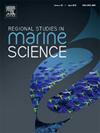Microplastics as sorption materials of herbicides, persistent organic pollutants (POPs) and polycyclic aromatic hydrocarbons (PAHs) in a coastal bay
IF 2.4
4区 环境科学与生态学
Q3 ECOLOGY
引用次数: 0
Abstract
Environmental plastic pollution is a major issue due to widespread distribution and persistence across air, land, water. Marine plastic pollution primarily stems from land-based human activities via water runoff, rivers, wastewater discharge, though marine activities also contribute. Coastal and estuarine areas are pollution hotspots for plastic debris and a widespread range of anthropogenic contaminants. The present work assess contamination by organic pollutants in the microplastics collected in a coastal ecosystem, the Bay of Brest, France, in comparison with samples of surrounding surface seawater and sediments. Chemical analysis targeted 21 polycyclic aromatic hydrocarbons (PAHs) including the 16 prioritised by the US Environmental Protection Agency, 14 polychlorinated biphenyl congeners (PCBs) including the 7 monitored by the OSPAR Convention and 25 pesticides. Results showed that PAHs concentrations were highest in sediments near industrial and urban zones. PCBs and pesticides were undetectable in surface water while still present in sediments, indicating historical pollution. Floating microplastics carried only six PAHs, the PCB congener 101, and two pesticides. Namely, the herbicides alachlor, banned years ago, and S-metolachlor were quantified exclusively on floating microplastics, suggesting ongoing contamination from land-based sources due to agricultural soils erosion and runoff in the estuary. These findings raise concerns about the role of microplastics as vectors of pollutants reflecting human activities, in this case agricultural. It highlights the need to improve monitoring and mitigation strategies on plastic wastes and associated contaminants in aquatic and soil environments to reduce the risk for bioaccumulation and toxicity in marine ecosystem.
海岸带微塑料对除草剂、持久性有机污染物(POPs)和多环芳烃(PAHs)的吸附
由于塑料在空气、土地和水中的广泛分布和持续存在,环境污染是一个主要问题。海洋塑料污染主要来自陆地上的人类活动,通过水径流、河流、废水排放,尽管海洋活动也有贡献。沿海和河口地区是塑料垃圾和各种人为污染物的污染热点。目前的工作评估了在法国布列斯特湾沿海生态系统中收集的微塑料中有机污染物的污染,并与周围表层海水和沉积物的样本进行了比较。化学分析的目标是21种多环芳烃(PAHs),包括美国环境保护局优先考虑的16种,14种多氯联苯同源物(PCBs),包括OSPAR公约监测的7种,以及25种农药。结果表明,靠近工业区和城区的沉积物中多环芳烃浓度最高。地表水中检测不到多氯联苯和农药,但沉积物中仍然存在,表明历史上存在污染。漂浮的微塑料只携带六种多环芳烃、多氯联苯同系物101和两种农药。也就是说,多年前被禁止使用的除草剂甲草胺和s -异甲草胺仅对漂浮的微塑料进行了量化,这表明由于农业土壤侵蚀和河口径流,陆地来源的污染正在持续。这些发现引起了人们对微塑料作为反映人类活动的污染物载体的作用的关注,在这种情况下是农业。它强调需要改进对水生和土壤环境中的塑料废物和相关污染物的监测和缓解战略,以减少海洋生态系统中生物积累和毒性的风险。
本文章由计算机程序翻译,如有差异,请以英文原文为准。
求助全文
约1分钟内获得全文
求助全文
来源期刊

Regional Studies in Marine Science
Agricultural and Biological Sciences-Ecology, Evolution, Behavior and Systematics
CiteScore
3.90
自引率
4.80%
发文量
336
审稿时长
69 days
期刊介绍:
REGIONAL STUDIES IN MARINE SCIENCE will publish scientifically sound papers on regional aspects of maritime and marine resources in estuaries, coastal zones, continental shelf, the seas and oceans.
 求助内容:
求助内容: 应助结果提醒方式:
应助结果提醒方式:


